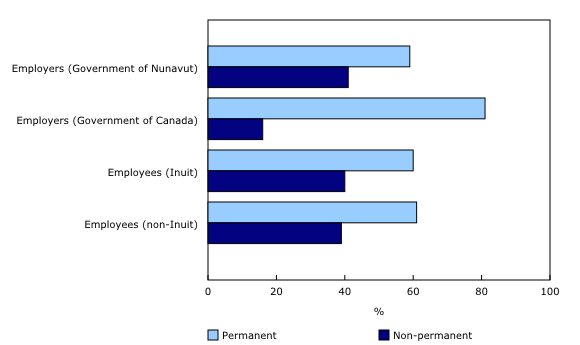Initial Findings from the Nunavut Government Employee Survey, 2016
Archived Content
Information identified as archived is provided for reference, research or recordkeeping purposes. It is not subject to the Government of Canada Web Standards and has not been altered or updated since it was archived. Please "contact us" to request a format other than those available.
Released: 2017-03-27
The public service is the largest employer in Nunavut. New data from the 2016 Nunavut Government Employee Survey contains information about conditions that create a good work environment, as well as potential barriers to the employment and retention of Inuit in the public service in Nunavut.
Approximately 6,300 employees work in the public sector in Nunavut—95% for the Government of Nunavut and 5% for the Government of Canada in Nunavut.
Of all government employees in Nunavut, just over half were Inuit (52%). Almost two-thirds (65%) of employees were female, whereas women accounted for less than half the territory's population (49%). Nearly half of all employees (49%) were 30 to 49 years old, older than the median age for Nunavut which was about 24.
More than half of government employees have permanent jobs
In total, just over 3 in 5 government employees held permanent (indeterminate) jobs. The other 2 in 5 employees held non-permanent positions that were seasonal, term, contract or casual.
However, the proportions of permanent and non-permanent workers varied depending on their employers. A majority (81%) of Government of Canada workers in Nunavut were employed in permanent positions. In comparison, a smaller percentage of Government of Nunavut employees (59%) reported working in permanent jobs. Both Inuit and non-Inuit employees were equally likely to report working in a permanent position.
Seven out of ten Inuit employees use an Inuit language at work
There are four official languages for the territory of Nunavut: the two Inuit languages (Inuktitut and Inuinnaqtun) and English and French. When asked which languages they could speak well enough to use at work, 36% responded "Inuktitut" and 3% responded "Inuinnaqtun."
In general, 38% of government employees in Nunavut "sometimes" or "often or always" used an Inuit language at work. When considering only Inuit, this percent was much larger—69% of Inuit employees "sometimes" or "often or always" used an Inuit language while at work.
Another way of exploring language use is to consider proficiency, or ability to speak, read, write and understand Inuktitut or Inuinnaqtun at work. Overall, 47% of employees were "proficient" or "somewhat proficient" in an Inuit language, while 53% were "not proficient." About eight times more Inuit employees (81%) were "proficient" in using these Inuit languages than their non-Inuit co-workers (9%).
More education and training opportunities are the best solutions to increase the number of Inuit employees in the government
Employees were asked to provide their opinion about the best solutions to increase the number of Inuit employees in the government. The responses selected by the largest percentage of Inuit employees included the importance of increasing on-the-job training, education and pre-employment training, and encouraging youth to pursue additional education.
Note to readers
The Nunavut Government Employee Survey surveyed 4,724 people from April 25 to June 24, 2016. Questions were developed by Statistics Canada in collaboration with Nunavut Tunngavik Incorporated, the Government of Nunavut and Employment and Social Development Canada.
There are many possible ways to define Inuit identity. On the census, for example, individuals can self-report Inuit as their Aboriginal identity or ancestry. For this analysis, the Inuit population was defined as those who had responded "yes" to the question in the Nunavut Government Employee Survey, "Are you enrolled under the Nunavut Land Claims Agreement?"
The Nunavut Land Claims Agreement or Nunavut Agreement, is an Agreement that was signed in May, 1993 by Nunavut Tunngavik Incorporated, the Government of Canada and the Government of the Northwest Territories. The terms of enrolment are defined under Article 35 of this agreement. One goal defined under Article 23 of this Agreement is a commitment to hire and retain more Inuit to work for the government by providing training or other support.
Inuit languages refers to findings that combine both Inuktitut and Inuinnaqtun.
Proficiency is a categorized level of proficiency based on four questions regarding respondents' perceived ability to use Inuktitut or Inuinnaqtun at work (that is, to speak, read, write and understand). In this analysis, respondents categorized as "proficient" or "somewhat proficient" in Inuktitut or Inuinnaqtun were grouped together as "proficient," and they were compared with others who were categorized as "not proficient."
Contact information
For more information, or to enquire about the concepts, methods or data quality of this release, contact us (toll-free 1-800-263-1136; 514-283-8300; STATCAN.infostats-infostats.STATCAN@canada.ca) or Media Relations (613-951-4636; STATCAN.mediahotline-ligneinfomedias.STATCAN@canada.ca).
- Date modified:


